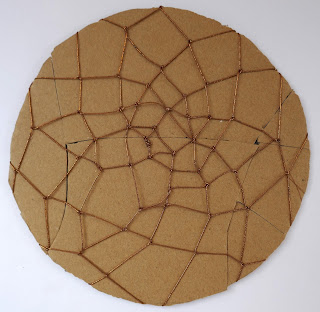fragmented
reflecting on the theme of “fragments” drew me back to a favourite plate which was broken – inspired by kinstugi i recreated it in stitch, but still wanted to do something with the broken fragments
I know it can not be repaired for use so any repair has to be for conservation or decoration – i'd love to repair it using the kintsugi method, but my medium is textile so that's where my heart leads me – also if I later feel I want to repair it another way a textile based repair would still leave me the option
…..but
how?
It's something I have considered repeatedly for several years
the best way is to experiment with some different approaches, so I
did
sample 1
inspired by Bridget Harvey's broken ceramic work – a cardboard “plate” repaired with copper coloured needlelace
this did not work for me as the fractures were not clear – but i realised that I want the fractures to show, so it helped me on the way to establishing my “rules for repair”:
I
want to show the fracture lines
the repair should add aesthetically to the plate
I
don't want to alter the plate permanently (yet)
the
design should be obscured as little as possible
the result need not be actually plate-shaped, but it should be recognisable
grey areas:
rigid
or flexible
fragmented
or whole
stand-alone or supported
stitching
in gold, colour or blending with cloth (white)
sample 2
inspired by a repaired vase I saw at a SIT Select exhibition in Newark Park Gloucestershire, 2014, I wish I had taken photos and noted the artist
using cotton organdie to partially wrap the fragments so that they can be stitched together like a patchwork – the method I used helped me to clarify my approach: this time I wrapped the pieces and stitched them together on the back, anchoring them on a backing fabric – this allowed me to carry out the final manipulation and stitching on individual pieces before stitching them together with functional and decorative stitch
as a result I know I can wrap each fragment and stitch the fabric into place as a frame, one at a time, before assembling all the pieces – the weight and resistance of the ceramic make this easier than with the card model, which warps and loses sharpness at the corners
the frame can be narrower, using the decorative needlelace edging to draw it tight with minimal visual obstruction of the design
but
the final question is which thread to use for the decorative stitch?:
a
hint of gold, echoing kintsugi,
colour
to echo the plate design
white








Comments